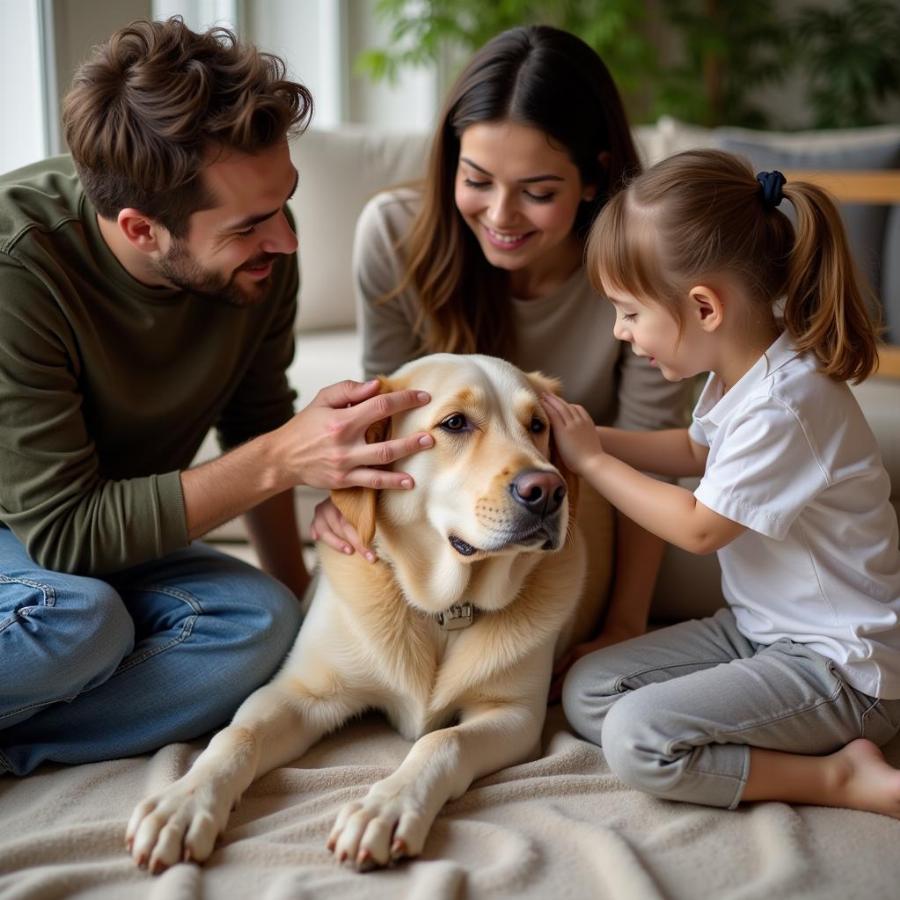Saying goodbye to a beloved dog is one of the most difficult decisions a pet owner can face. When illness, old age, or an untreatable condition affects your furry friend’s quality of life, euthanasia, also known as “putting a dog to sleep,” becomes a compassionate choice. While heartbreaking, understanding the process and taking proactive steps can help make this final act of love as peaceful and comforting as possible for both you and your cherished companion.
Understanding Euthanasia for Dogs
Euthanasia involves a veterinarian administering a high dose of a specific medication, typically pentobarbital, which gently slows down the heart and brain activity, resulting in a painless passing. The procedure is generally quick, taking only a few minutes.
Recognizing When It’s Time
Determining the right time for euthanasia is a deeply personal decision. Consult with your veterinarian to assess your dog’s condition and prognosis. Factors to consider include:
- Quality of Life: Has your dog lost interest in things they once enjoyed, like walks, meals, or playtime with family?
- Pain Management: Are you struggling to manage your dog’s pain effectively, even with medication?
- Mobility: Is your dog experiencing significant difficulty moving, standing, or controlling their bladder/bowel movements?
Talking to your veterinarian about these factors can help you assess if your dog’s quality of life is declining beyond what can be reasonably managed.
Questions to Ask Your Veterinarian
Open and honest communication with your veterinarian is crucial during this time. Don’t hesitate to ask questions like:
- What are the treatment options for my dog’s condition?
- What are the potential side effects of those treatments?
- What kind of pain management can you offer my dog?
- How will I know when it’s time?
- Can you explain the euthanasia procedure?
- Can I be present with my dog?
Planning for the Procedure
Once the difficult decision has been made, here are some things to consider:
1. Location: You can choose to have the procedure done at your veterinarian’s office or, in some cases, at your home.
2. Presence: Decide if you want to be present during the procedure. Many find comfort in being with their dog in their final moments, while others prefer to say their goodbyes beforehand.
3. Aftercare: Discuss aftercare options with your vet. You may choose to take your dog’s body home for burial, or your vet can discuss cremation services.
4. Emotional Support: Lean on friends, family, or a grief counselor during this difficult time.
Saying Goodbye
Allow yourself and your family members to say goodbye to your dog in your own way. Spending quality time together, reminiscing about cherished memories, and offering comfort will help ease the transition.
 Family saying goodbye to their beloved dog
Family saying goodbye to their beloved dog
Coping with Loss
The grief of losing a dog is real and valid. Allow yourself time to grieve and don’t be afraid to seek support from those around you. Remember the joy your furry friend brought into your life and cherish the memories you shared.
“I can’t imagine doing this, but I know it’s the kindest thing for her,” says Sarah, a Beaut Dogs reader, about her aging Labrador. “Your article gave me the courage to talk to my vet openly. Thank you.”
Frequently Asked Questions
1. Will my dog feel any pain during euthanasia?
Euthanasia is designed to be peaceful and pain-free. The medication works quickly to slow down heart rate and brain activity, allowing for a gentle passing.
2. How much does euthanasia cost?
The cost can vary depending on your location and veterinary practice. Contact your vet for a price estimate.
3. What happens to my dog’s body after euthanasia?
You have the option to take your dog’s body home for burial, or your veterinarian can discuss cremation services.
4. How can I help my other pets cope?
Dogs can sense loss, so allowing them to see and smell your deceased dog can help them understand what has happened. Maintain their routine as much as possible to provide stability.
5. Is it normal to feel guilty after euthanasia?
Feelings of guilt are common after euthanasia. Remember that you made the kindest decision for your dog based on their well-being.
Need more support?
Navigating the final stages of your dog’s life is never easy. For more information and guidance on end-of-life care and other important topics related to dog ownership, visit our homepage at Beaut Dogs. You are not alone.
Beaut Dogs is your trusted source for all things related to dog care. When you need expert advice and compassionate support, reach out to us at [email protected]. We’re here to help you through every stage of your dog’s life journey.